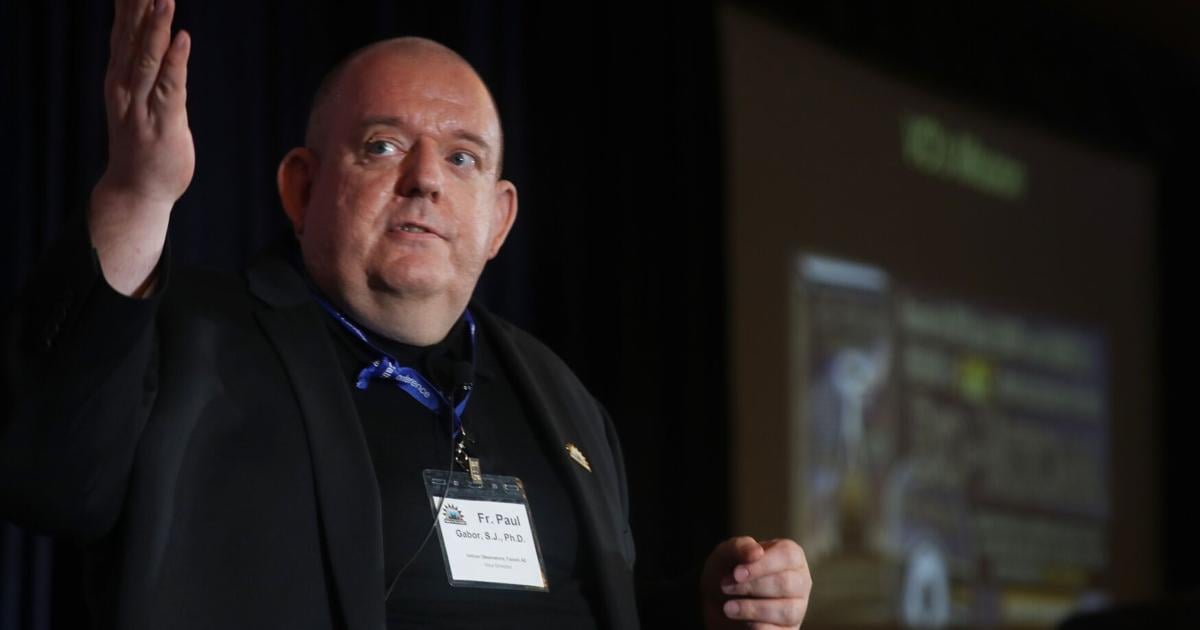Jesuit Father Paul Gabor, vice director of the Vatican Observatory Research Group in Tucson, Ariz., delivers a keynote speech June 25, 2025, during the Catholic Media Conference in Phoenix. He addressed the question, ‘Why Does the Pope Have an Astrophysics Research Institute?” (OSV News photo/Bob Roller)
Bob Roller
PHOENIX | The Vatican Observatory attests that “science is not against God” — and the nexus of science and spirituality invites humankind to contemplate the Lord’s wondrous works, said a Jesuit astrophysicist.
Father Pavel Gabor, vice director of the Vatican Observatory Research Group in Tucson, Arizona, shared his insights in a June 25 keynote address at the 2025 Catholic Media Conference, held June 24-27 in Phoenix.
At a luncheon sponsored by the Pontifical Mission Societies USA, Father Gabor addressed the question, “Why Does the Pope Have an Astrophysics Research Institute?”
Father Gabor — who seasoned his lunchtime talk with wry wit and deadpan humor — said many are actually unaware of the Vatican Observatory’s existence, even though it’s one of the oldest astronomical institutes in the world.
The observatory traces its roots to the solar calendar reform of Pope Gregory XIII in 1582, which corrected a widening gap between the calendar and the seasons incurred by the Julian calendar. With a papal committee studying the scientific data necessary for the reform, the Vatican’s commitment to ongoing astronomical research was born.
Early observatories founded by the Vatican, along with the work of Jesuit Father Angelo Secchi — a pioneer of astrophysics who was the first to classify stars according to their spectra, or indicators of temperature, luminosity and chemical makeup — ultimately led Pope Leo XIII in 1891 to formally refound the Specola Vaticana (Vatican Observatory), the predecessor for which had operated from 1789-1821.
However, said Father Gabor, light pollution that accompanied Rome’s expansion over time compelled Pope Pius XI to move the observatory to Castel Gandolfo, the papal summer residence, about 15 miles from Rome.
In 1981, light pollution again prompted a new development in the observatory’s history — this time, through the building of a second research center, the Vatican Observatory Research Group in Tucson, where Father Gabor is based. The Vatican teamed up with the University of Arizona’s Steward Observatory to construct the Vatican Advanced Technology Telescope on Mount Graham, Arizona, a project completed in 1993.
The VATT survived the 2017 Frye Fire, sparked by a lighting strike on Mount Graham, with Father Gabor showing photos and video of the smoke obscuring the structures.
However, he said, the VATT has at times been engulfed by the flames of controversy, thanks to the work of conspiracy theorists, some of whom have asserted the site is a “portal to another dimension on Mount Graham” — one designed to welcome an alien savior, as authors Tom Horn and Cris Putnam alleged in several books.
Father Gabor admitted that countering such speculations was “one of the first things I had to deal with when I came to Tucson.”
But Scripture and nature — what theologians have traditionally called “God’s two books” — tell a more plausible and profound story, said Father Gabor, whose research interests include astrophysics instrumentation and extrasolar planets, or exoplanets, which orbit stars other than the sun.
He quoted 17th-century French scientist and religious philosopher Blaise Pascal, who in his book “Penseés” wrote, “The eternal silence of these infinite spaces terrifies me” (“Le silence éternel de ces espaces infinis m’effraie”).
“The book of nature is ambiguous if you’re like the atheist in Pascal’s ‘Penseés,'” said Father Gabor. “But if you are a believer and have the grace of faith, you see the universe as something that speaks to you.”
Father Gabor said scientists hold that latter view, as does the author of Psalm 8, who marveled, “When I see your heavens, the work of your fingers, the moon and stars that you set in place — what is man that you are mindful of him, and a son of man that you care for him?” (Ps 8:4-5)
Italian astronomer and scientific pioneer Galileo Galilei himself found his research an occasion for gratitude, said Father Gabor, pointing to a 1610 letter in which Galileo wrote, “I give infinite thanks to God who has been pleased to make me the first observer of marvelous things.”
Scientists “are halfway believers at best,” quipped Father Gabor.
He echoed the insights of French astronomer Catherine Cesarski, who said UNESCO’s International Year of Astronomy in 2009 was a call to behold the universe and recognize humanity’s place in it.
“If we manage to get every individual to gaze at the stars at least once this year and realize how wonderful, how magnificent this Earth is and how petty our earthly squabbles are,” said Father Gabor.

